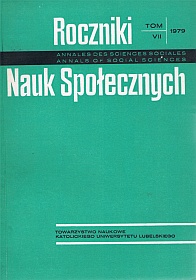Wkład gospodarczy pokolenia Polski niepodległej (1918-1939)
Abstrakt
Polish economy in the eve of independence has difficult situation. On the one hand there were war ruins (almost in 100 per cent in industry, apart from Upper Silesia, which was undestroyed), in serious degree agriculture — one third, and also transport and communication. On the other hand Polish economy was acting in interest of three partitioners (Russia, Prussia, Austria).
War ruins in industry and communication were removed till 1924, and in agriculture — in 1925.
In the peace period of 17 years (wars dured in polish lands from 1914 till 1921) people of Poland made significant changes in the infrastructure (social overhead capital) and in superstructure (industry, agriculture and services).
In the domain of infrastructure: There were built solid, changeable value, polish central bank and the well prosperous saving and credit system.
In the domain of education: there were introduced primary school system for almost all people. There were developed significantly secondary and upper schools.
In the domain of health: there were developed hospitals, near ten times, and the number of physicians were almost trebled.
In the domain of social legislation: there were edited many modern laws respecting personal rights (rights to strike, to crating trade unions, independent from a government, woman rights, insurance rights and so on).
Polish system of administration were efficient and uncorrupted.
There were built 1800 km of railway lines (in general dimensions 20 thousands of km in Poland), 19 000 km of macadamized roads (in 63 000 km). There were built from the foundation polish port in Gdynia, which was most modern port in Baltic Sea. Port in Gdańsk belonged to the Free City of Gdańsk, but 90 per cent of transshipping went to and from Poland. There were quick development of telecomunication (radio, telephones, post) and airlines.
In the domain of agriculture: After elimination of war devastation, agricultural production grew about three per cent yearly. Agrarian reforms gave to the peasants near three millions of hectares of soils. Meliorations were made on half of million hectare. Integrations of lands were made in more then five million hectares.
In the domain of industry: There were stagnation in extractive industries — which production were exported in colonial period. In the period of independency almost ail of this production was directed in Poland.
There were declined of production of alcoholic industry near three times, and tobacco industry
There were developed modern manufacturing industries: From the basis there was built airplane industry. Polish pilots in Challenge (International European Airplane Competitions) in 1932 and 1934 on polish planes had victory. Polish airplanes were defender of sky of Poland, Etiopia and Greece, polish airplanes were also sold to Latvija, Estonia, Rumania, Hungary Bulgaria, Yougoslavia and Turkey.
There were well beginnings of machine industry and electric industry. Production of electric energy has grown six times.
There were built and developed transport industries (locomotive and carriage). There were beginnings of automobile industry. The first polish seaship was launched in polish shipbuilding yard in Gdynia in 1939.
There were built from zero armament industry,— polish army in 1939 was armed only in polish arms (Apart from navy, which was built in Western Europe shipbuilding yards, from French state loans). Armament industry was conditio sine que non of Poland's independence.
In 1936 till 1938 was realized first polish economic Plan: to help underdeveloped regions in Poland and to strengten the polish army. Investment were private (3/4) and from government (1/4)."State encouraged private initiative by tax reductions and credits.
In 1939 there were planned new economic plan for 15 years, which wanted to liquidate disguise underdevelopemnt in country, to built full tine of communications in uderdeveloped regions of Poland, to built such armament industry which could enabled to Poland to defense his independence, and to make such investment in underdeveloped regions of Poland that were realized social justice for all people of Poland. But these dreams were stopped by imperialistic attack on Poland in· September 1939.
The period of independence was the period of without parallel economic and social activities of all generation. But it should be mentioned some names: profesor Władysław Grabski, value reformer in 1924, Hubert Linde — founder of original polish saving and credit system — specific for polish conditions, docent Władysław Kosieradzki — promotor „originator" of specific polish economic plan, and Minister of Finance, engineer Eugeniusz Kwiatkowski, realizer, who also built with many people the port in Gdynia, general of polish airforce Ludomir Rayski, who urged the development of polish industry. There were many world-famous polish people of knowledge — profesor Ignacy Mościcki, chemist eng. Sędzimir, Florian Znaniecki and Bronislaw Malinowski — the sociologists, and so on. There were many polish engineers in electric industry (founders of replica „Enigma"), aircraft industry, machine industry and so on. About ninty pet cent of polish ntelligency was killed during second world war.
Copyright (c) 1979 Roczniki Nauk Społecznych

Utwór dostępny jest na licencji Creative Commons Uznanie autorstwa – Użycie niekomercyjne – Bez utworów zależnych 4.0 Międzynarodowe.


